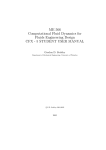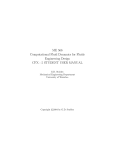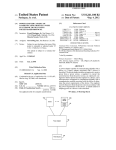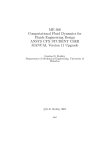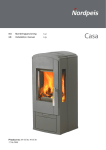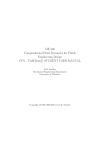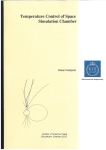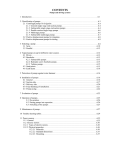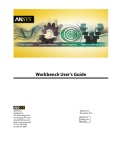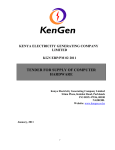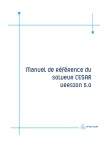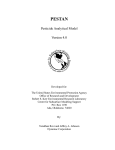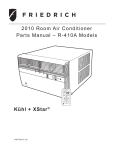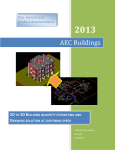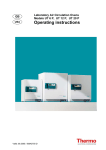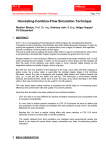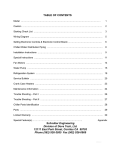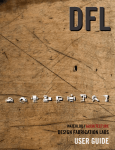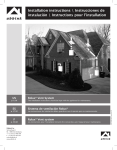Download ME 566 Computational Fluid Dynamics for Fluids Engineering
Transcript
ME 566
Computational Fluid Dynamics for Fluids Engineering
Design
ANSYS CFX STUDENT USER MANUAL Version 11
Gordon D. Stubley
Department of Mechanical Engineering, University of Waterloo
©G.D. Stubley 2008
January 30, 2008
1
Contents
Contents
i
Preface
I
1
2
iii
Tutorial
1
Overview of CFD Process
1.1 Example Problem . . . . . . . .
1.2 Domain . . . . . . . . . . . . . . .
1.3 Domain Descritization: Mesh
1.4 CFD Flow Solver . . . . . . . . .
1.5 Post-processing . . . . . . . . . .
.
.
.
.
.
2
2
2
3
4
8
Tutorial Commands
2.1 Introduction to the GUI . . . . . . . . . . . . . . . . . . . . . . . . . . . . .
2.2 Commands for Duct Bend Example . . . . . . . . . . . . . . . . . . . . .
10
10
13
.
.
.
.
.
.
.
.
.
.
.
.
.
.
.
.
.
.
.
.
.
.
.
.
.
.
.
.
.
.
.
.
.
.
.
.
.
.
.
.
.
.
.
.
.
.
.
.
.
.
.
.
.
.
.
.
.
.
.
.
.
.
.
.
.
.
.
.
.
.
.
.
.
.
.
.
.
.
.
.
.
.
.
.
.
.
.
.
.
.
.
.
.
.
.
.
.
.
.
.
.
.
.
.
.
.
.
.
.
.
.
.
.
.
.
.
.
.
.
.
II Additional Notes
30
3
Geometry and Mesh Specification
3.1 Basic Geometry Concepts and Definitions . . . . . . . . . . . . . . . . .
3.2 Geometry Creation . . . . . . . . . . . . . . . . . . . . . . . . . . . . . . . .
3.3 Mesh Generation . . . . . . . . . . . . . . . . . . . . . . . . . . . . . . . . . .
31
31
32
34
4
CFX-Pre: Physical Modelling
4.1 Domain . . . . . . . . . . . .
4.2 Initialization . . . . . . . . .
4.3 Output Control . . . . . . .
4.4 Simulation Type . . . . . .
4.5 Solver Control . . . . . . .
.
.
.
.
.
42
43
46
47
47
47
CFX Solver Manager: Solver Operation
5.1 Monitoring the Solver Run . . . . . . . . . . . . . . . . . . . . . . . . . . .
49
49
5
.
.
.
.
.
.
.
.
.
.
.
.
.
.
.
.
.
.
.
.
i
.
.
.
.
.
.
.
.
.
.
.
.
.
.
.
.
.
.
.
.
.
.
.
.
.
.
.
.
.
.
.
.
.
.
.
.
.
.
.
.
.
.
.
.
.
.
.
.
.
.
.
.
.
.
.
.
.
.
.
.
.
.
.
.
.
.
.
.
.
.
.
.
.
.
.
.
.
.
.
.
.
.
.
.
.
.
.
.
.
.
.
.
.
.
.
.
.
.
.
.
.
.
.
.
.
.
.
.
.
.
.
.
.
.
.
Contents
6
7
CFX-Post: Visualization and Analysis of Results
6.1 Conventions . . . . . . . . . . . . . . . . . . . . . .
6.2 Objects . . . . . . . . . . . . . . . . . . . . . . . . .
6.3 Tools . . . . . . . . . . . . . . . . . . . . . . . . . . .
6.4 Controls . . . . . . . . . . . . . . . . . . . . . . . .
ii
.
.
.
.
.
.
.
.
.
.
.
.
.
.
.
.
.
.
.
.
.
.
.
.
.
.
.
.
.
.
.
.
.
.
.
.
.
.
.
.
.
.
.
.
.
.
.
.
.
.
.
.
.
.
.
.
.
.
.
.
Frequently Asked Questions
7.1 Where are the ANSYS-CFX tutorial files? . . . . . . . . . . . . . . . . . .
7.2 How to use an existing mesh after modifying the geometry? . . . . .
7.3 How to use an existing CFX-Pre model after modifying the mesh? .
7.4 How is heat conduction modelled in a single domain? . . . . . . . . . .
7.5 Why is there only a few point values given when exporting data
along a line normal to a wall? . . . . . . . . . . . . . . . . . . . . . . . . . .
7.6 How is a thin guide vane modelled? . . . . . . . . . . . . . . . . . . . . . .
52
52
54
55
56
57
57
57
57
57
58
58
Preface
In these notes the basic steps in a CFD solution will be illustrated using the professional software ANSYS Workbench Version 11which includes the components
DesignModeler, Meshing, and Advanced CFD (all trademarks of ANSYS). These
notes include an introductory tutorial and a mini user’s guide. In particular, the
notes are pertinent to the simulation of two dimensional steady incompressible
laminar and turbulent fluid flows on stationary meshes. They are not meant to replace a detailed user’s guide. For full information on these components refer to the
on-line help documentation provided with the software 1 .
These notes include sections on:
Overview of CFD Simulation An introductory section outlining the components
of a CFD simulation. Includes the description of an example CFD analysis
problem;
Commands for the Example Problem: A complete step-by-step list of instructions
for solving the example problem.
Software Components: A description of the concepts and operation involved in
the five software components: DesignModeler, Meshing, CFX-Pre, CFXSolver, and CFX-Post; and
Frequently Asked Questions: Suggestions for further study and for solving typical flow cases.
The following font/format conventions are used to indicate the various commands that should be invoked:
Menu/Sub-Menu/Sub-Sub-Menu
Item chosen from the menu hierarchy at the top of a
main panel or window,
Button/Tab Command
Link description
Name
va l u e
Option activated by clicking on a button or tab,
Click on the description to move by a link to the next step/page;
Enter the va l u e in the named box,
1 Many of the features available in these software components will not be explored in introductory
CFD courses.
iii
PREFACE
Name
È selection Choose the selection(s) from the named list,
Name
Panel or window name,
Name On/off switch box, and
Name On/off switch circle (radio button).
iv
Part I
Tutorial
1
Chapter 1
Overview of CFD Process
1.1
Example Problem
To provide a context for these notes consider the application of CFD to studying
the flow in a short radius bend within the duct system shown in Figure 1.1. There
is a flow of water upwards into the bend.
The side view of the duct bend geometry is shown in Figure 1.2. The radius
of the inner wall bend is R1 = 0.025[m]. The spacing between the duct inner wall
and outer wall is H 3 = 0.1[m]. The duct has a width (into the page) of 1[m]. The
average speed of the water flow through the duct is 3[m/s ].
The purpose of the CFD analysis is to determine if and where flow separation is
an issue. CFD is well suited to this task because it can provide a detailed representation of the velocity and pressure fields throughout the flow domain. By examining
the velocity field it will be possible to identify regions where the flow separates and
reverses direction and by examining the pressure field it will be possible to identify
regions where flow reversal is likely to occur. In this chapter a brief description of
how these field properties are determined is presented.
1.2
Domain
The CFD simulation is restricted to a specific three dimensional region known as
the domain. For the duct bend example, the domain, shown in Figures 1.1 and 1.2,
is a thin volume that is bounded by the outer wall, the inner wall, by planes perpendicular to the flow upstream and downstream of the bend, and by surfaces in
the x − y plane on the front and back sides. The domain extends V 2 = 0.1[m] upstream from the bend and H 4 = 0.25[m] downstream from the bend. The domain
is 0.02[m] wide.
The geometry of the domain is represented in digital form by solid modelling
software. The resulting geometric model is known as a solid or solid-body for historical reasons. The volume of the solid geometric model is the volume where the
fluid flow is modelled.
2
CHAPTER 1. OVERVIEW OF CFD PROCESS
3
CFD Domain
y
z
x
Figure 1.1: Schematic of the region near a short radius bend in a duct system. Water
is flowing upwards into the bend and to the right out of the bend. A wireframe
representation of the CFD flow domain is also shown.
1.3
Domain Descritization: Mesh
It is not possible to analytically determine mathematical functions for the variation
of velocity and pressure throughout complex domains. Therefore approximate values of the velocity components, Ui , i = 1, 2, 3,1 and pressure, p, are generated only
at discrete points or nodes throughout the domain. The locations of the nodes are
based on a mesh. A mesh for the duct bend geometry is shown in Figure 1.3.
The mesh is comprised of a set of relatively simple three dimensional polyhedral
elements. The example mesh is comprised of hexahedral elements. For all meshes,
the set of elements is non-overlapping, fills the domain, and fits the boundaries of
the domain. For CFX meshes, the nodes are located at the vertices of the elements.
The example mesh is only one element thick in the z direction and the surface
meshes on the front and back surfaces are identical. This is suitable for this flow
because there is no significant variation of flow properties in the z direction.
1 Index notation is used in these notes, where the x,y, and z directions are indicated by indices 1,2,
and 3 respectively.
CHAPTER 1. OVERVIEW OF CFD PROCESS
4
Figure 1.2: Solid body model of the duct bend geometry included in the CFD flow
domain.
1.4
CFD Flow Solver
CFD software assumes that each node is surrounded by a finite control volume
bounded by planar faces as illustrated in Figure 1.3. By applying the principles of
conservation of momentum and mass to each control volume, a set of finite volume
equations are formed which can be solved to provide nodal values of velocity and
pressure.
After a mesh has been generated, there are three major steps to create a simulation of the velocity and pressure fields on the mesh:
Flow Model Specification: identify all significant flow processes (such as advective
flows and stress tensor forces) and their appropriate models;
Finite Volume Equation Generation: apply a set of numerical approximations to
estimate all control volume flow processes in terms of the nodal field property
values. When applied to the conservation principles, this leads to a set of finite
volume equations; and
Finite Volume Equation Solution: use a nonlinear matrix solution algorithm to
solve the equation set for estimates of the nodal values of velocity and pressure.
CHAPTER 1. OVERVIEW OF CFD PROCESS
5
Figure 1.3: Mesh of hexahedral elements for the duct bend geometry showing a
typical node and finite control volume.
By convention the software that performs these three steps is referred to as the CFD
flow solver.
Flow Model Specification
The first step of the CFD flow solver requires input from the CFD analyst to identify the relevant flow processes and to choose suitable models for these processes.
For the example problem of flow through the duct bend:
• Type of Flow: the flow is modelled as turbulent, non-buoyant, steady in the
mean flow properties, and doesn’t involve heat transfer;
• Fluid Type and Properties: the fluid, water, is modelled as a constant property
Newtonian liquid, with a density of ρ = 1000[k g /m 3 ] and dynamic viscosity
of µ = 0.001[Pa s ];
• Flow Domain Properties: the domain is modelled as stationary;
• Turbulence Model: the mean action of the turbulent eddying motion on
the mean velocity field is accounted for with the k-epsilon (k − ") model. In
CHAPTER 1. OVERVIEW OF CFD PROCESS
6
this model, the turbulent Reynolds stresses, −ρui0 u 0j , are related to the mean
velocity strain rate by
!
∂ Ui ∂ Uj
0 0
+
−ρui u j ≈ µ t
∂ xj
∂ xi
where the turbulent viscosity, µ t , is proportional to the fluid density, the
velocity scale (intensity) of the turbulent eddies, and the length scale of the
eddies. The scales of the turbulent eddying motion are estimated from two
field properties of the turbulence which are calculated at each node: k, mean
turbulent kinetic energy (i.e. kinetic energy associated with swirling turbulent eddies) and ", the rate at which k is dissipated by molecular action; and
• Boundary Conditions: modelling the influence of the surroundings on the
flow domain are specified for each surface on the flow domain and are modelled as:
– [Inflow Surface:] with a uniform normal velocity of Vi n = 3[m/s ],
p
turbulent intensity, I ≡
0.01[m];
k
Vi n
= 5%, and turbulent length scale, l ≡
3
k2
"
=
– [Outflow Surface:] with a uniform relative pressure of 0[Pa];
– [Inner and Outer Walls:] modelled as smooth no-slip walls. The turbulent wall shear stress is estimated with the Law of the Wall for equilibrium turbulent boundary layers;
– [Front and Back Surfaces:] modelled as symmetry surfaces implying
no mass flow across these surfaces and all normal gradients are zero.
Finite Volume Equation Generation
As mentioned above, a finite control volume surrounds each node in the mesh.
Once calculated the nodal field values are representative average values for their
respective control volumes. To calculate the nodal field values a set of discrete algebraic equations based upon conservation principles are formed. For the duct bend
example, these equations are based on conservation of mass, momentum in 3 directions, x, y, and z, turbulent kinetic energy, and its dissipation rate.
The finite volume methodology can be illustrated with a simplified discussion
of the generation of the discrete mass conservation equation. Consider mass conservation for the control volume surrounding the P node shown in Figure 1.3. With
the specified steady incompressible flow model, mass conservation implies that the
sum of mass flows across the faces of the P control volume must balance or
X
~
0=
ρV
(1.1)
face · n̂Aface
faces
~
where V
face is the face average velocity, n̂ is the face outwards pointing unit normal
vector, and Aface is the face area. Notice that Equation 1.1 provides a relationship in
CHAPTER 1. OVERVIEW OF CFD PROCESS
7
terms of face velocities and not one in terms of the nodal velocities. However, each
interior face separates two neighbour nodes. If numerical interpolation functions
are used to estimate the face velocities in terms of the neighbour nodal values then
a useful discrete mass conservation equation can be formed in terms of the nodal
values.
Typically the interpolation functions assume some form of linear interpolation.
While largely prescribed by the CFD software, the choice of certain interpolation
functions can be set by the CFD analyst.
For the duct bend example the following interpolation functions are specified:
Mass flows: linear-linear-linear interpolation;
Diffusive flows: linear-linear-linear interpolation;
Advective flows: upwind weighted linear interpolation based on nodal values and
gradient estimates (high resolution scheme)
Pressure forces: linear-linear-linear interpolation; and
Stress tensor forces: linear-linear-linear interpolation.
Finite Volume Equation Solution
For the duct bend example, there are five unknown field properties at each node,
pressure, three velocity components, turbulent kinetic energy, and its dissipation
rate. As explained above, five corresponding discrete algebraic equations can be
generated for each node based on conservation of mass, momentum in three directions, turbulent kinetic energy, and its dissipation rate. Therefore, once finite
volume equations are generated for each node there is a set of equations which can
be solved to determine estimates of the nodal field properties.
This equation set is highly coupled, both linearly and nonlinearly. Therefore an
iterative solution algorithm is implemented in the CFD solver to obtain estimates
of the nodal field properties. The essence of the algorithm:
1. Make an initial guess for each field property at each node;
2. Determine the imbalance, residual, in each finite volume conservation equation. If the residual imbalance values are sufficiently small stop the iteration.
If not continue with the following:
3. Use the residual values to estimate improved values for the nodal field property values;
4. Return to Step 2.
CHAPTER 1. OVERVIEW OF CFD PROCESS
8
Figure 1.4: Vector plot of the simulated flow field through a duct bend showing
separated flow on the inner wall downstream of the bend.
1.5
Post-processing
The CFD flow solver provides estimates of fundamental field properties at each
node. Often this information is insufficient. For example, in the duct bend flow it
is necessary to know the extent of the possible separated flow regions and the drop
in total pressure through the bend. This information is found by post-processing
the nodal values to provide graphic images or to calculate secondary values of direct
relevance to evaluating the flow.
Figure 1.4 shows a vector plot of the simulated flow through the duct bend. A
separated flow region adjacent to the inner wall downstream of the bend is clearly
seen. Regions of high speed and low speed flow are also seen in this visualization.
A summary of the complete CFD model including meshing details is shown in
Figure 1.5.
Figure 1.5: Summary of the CFD model for flow through a duct bend.
CHAPTER 1. OVERVIEW OF CFD PROCESS
9
Chapter 2
Tutorial Commands
2.1
Introduction to the GUI
Windows XP/NEXUS
The CFD software is available on the workstations in the Engineering Computing labs, Fulcrum (E2-1313), Wedge (E2-1302B), Helix (RCH-108), and WEEF (E21310), and the Mechanical Engineering 4th year computing room, E3-3110. The
workstations use the Windows XP operating system on Waterloo NEXUS. You
should be familiar with techniques to create new folders (or directories), to delete
files, to move through the folder (directory) system with Windows Explorer, to
open programs through the Start menu on the Desktop toolbar, to move, resize,
and close windows, and to manage disk space usage with tools like WinZip.
Introduction to Workbench
The ANSYS Workbench environment provides an interface to manage the files
and databases associated with the individual software components. These files and
databases are organized into a particular project. To get a feel for this environment and the GUIs associated with the software components, we will look at a
pre-prepared project on flow through a pipe bend.
1. Create a working directory called CFDTest on your N drive.
2. Use a web browser to visit the UW-ACE ME 566 course page (uwace.uwaterloo.ca).
Under the Lessons tab and open the Student User Manual folder. Click on the
link to PipeBend.zip and follow the instructions to download the archive containing the working files.
3. Use WinZip to extract the files in the PipeBend archive into your working
directory.
4. Open ANSYS Workbench from
Start/Programs/Engineering/ANSYS 11.0/ANSYS Workbench.
10
CHAPTER 2. TUTORIAL COMMANDS
11
5. Open the project file. Check that Open: È Workbench Project is selected before using the Browse button below the Open: Workbench Projects panel area
to find and selecting the file PipeBend.wbdb from your working directory.
6. There are three main areas on the screen: command menus, buttons, and tabs
at the top, a list of potential Project Tasks on the left, and a list of the files
linked to the project.
7. On-line help for Workbench, DesignModeler, and CFX-Mesh is available in
web-page format similar to other Windows programs. Choose Help/ANSYS
Workbench Help to open the ANSYS Workbench Documentation. Search for
keyword Tutorials and select CFX-Mesh Help. Follow the Tutorials link to see
the list of available tutorials.
Introduction to DesignModeler/CFX-Mesh GUI
1. In the Workbench file area click on the item name PipeBend just to the right
of the DesignModeler button ( DM ). Notice that the Project Tasks area at
the left adjusts to reflect your choice. Under DesignModeler Tasks choose
Open to open the geometry file.
2. A new page for DesignModeler will open. Go back to the Project page by
clicking on the PipeBend [Project] tab at the top left of the screen. Click on
the PipeBend [DesignModeler] tab to return to the DesignModeler page.
3. There are four major areas on the page: command menus and buttons at
the top, a Tree View and Sketch Toolbox on the left, a Details View at the
bottom left, and a Model View window. Place the mouse cursor over one
of the command buttons in the top row. A brief description of the button’s
action should appear (you may need to click in the window once to make it
active). Visit each button with the mouse cursor to see its action.
4. One method of controlling the view is with the coordinate system triad in
the lower right corner of Model View. Click on the Z axis of the triad to see
a back view of the pipe bend. Click on the cyan sphere to select the isometric
view.
5. Another method of controlling the view is with the mouse left button in
conjunction with a mouse action selection. From the upper row of buttons,
select the Pan action. Holding the left mouse button down, drag the mouse
over the Model View to translate the view. Select the Zoom action and
repeat with an up-down mouse action to change the size of the view.
6. Select the Rotate action. The rotate action is context sensitive in that it
depends upon the position of the mouse cursor. With the mouse cursor close
to the pipe bend, press the left mouse button to get free 3D rotation. The point
CHAPTER 2. TUTORIAL COMMANDS
12
of rotation can be changed by clicking the left button while the cursor is on
the pipe bend surface (this may take some experimentation). With the mouse
cursor in a corner of the Model View, press and hold the left mouse button
to get a roll action in which there is 2D rotation about an axis perpendicular
to the Model View window. Move the cursor to either the left or right of
the Model View and hold the left button to get a yaw action in which there
is 2D rotation about the vertical axis. Move the cursor to either the top or
bottom of the Model View and hold the left button to get a pitch action in
which there is 2D rotation about the horizontal axis.
7. Rotate, zoom, and pan actions can be achieved directly by pressing the middle
mouse key alone, with the Shift key, and with the Ctrl key, respectively.
8. The Tree View on the left shows the geometric entities that were used to
generate the cylinder. Expand the 1 Part, 1 Body entity and click on Solid to
see some properties of the cylinder in the Details View. The pipe bend was
generated from two entities:
a) Sketch1: which can be found in the Plane4 entity. Click on Sketch1 to
highlight the circle that the pipe bend is based upon with yellow.
b) Sketch2:. which can be found in the YZPlane entity. Click on the Sketch2
to highlight the path that is swept out by Sketch1 to generate the pipe
bend.
9. In the help page search for keywords rotation modes and select "Rotation Cursors in the Rotate Mode" to find more information on changing the view.
10. Click the X button on the PipeBend [DesignModeler] tab to close the DesignModeler page. You can click No to quit without saving changes.
Introduction to the Advanced CFD GUI
The tasks associated with CFD simulation in Workbench are referred to as Advanced CFD Tasks. For historical reasons, the GUI for the three Advanced CFD
Tasks is slightly different from that of the other Workbench components. We will
use CFX-Post to look at the completed simulation of flow through a pipe bend to
get a feel for these differences.
1. In the Workbench file area click on the item name PipeBend_001. Under Advanced CFD Tasks, choose Open in CFX-Post to open the results file (PipeBend_001.res).
All of the pertinent CFD model data (mesh, flow attributes, and boundary
condition information) for this problem is stored in this file.
2. A new page for CFX-Post will open.
3. There are three major areas on the screen: Command menus and buttons at
the top, outline and detail panels on the left, and 3D Viewer window. Wireframe models of the pipe inlet and outlet should be in the Viewer. To see the
CHAPTER 2. TUTORIAL COMMANDS
13
pipe bend click the Domain 1 Default object on in the tree under PipeBend_OO1
and Domain 1 in the Outline panel.
4. The mouse button action for controlling the view is similar to that in DesignModeler.
5. The coordinate system triad is shown in the lower right corner. Unlike in
DesignModeler, the triad cannot be used to change the view. To set standard
directional views type x, y, or z while the Viewer window is active to get
views in the positive axis directions and type X, Y, or Y to get views in the
negative axis directions. Other standard key mappings can be seen by clicking
on the Show Help Dialog icon at the right of the lower row of icon buttons.
6. On-line help is available, Help. Open the main table of contents, Help/Master
Contents. Context-sensitive help is also available. Right click on Default Legend View 1
object and choose Edit. Position the mouse pointer in the Details of Default
Legend View 1 panel and press <F1> to bring up the help page for that panel.
7. This should give a sense of the operation of the Advanced CFD GUI. When
you have finished, return to the Workbench Project page. Exit by File/Close
Project and choose No: do not save any items.
8. Clean up by deleting the CFXTest directory.
2.2
Commands for Duct Bend Example
To set-up the project files and options:
• Create a new folder N:/Ductbend1 to be the working directory for the project
files.
• Open ANSYS Workbench from
Start/Programs/Engineering/ANSYS 11.0/ANSYS Workbench.
To open a new project:
1. In the Start window, select Empty Project in the New panel,
2. From the menu bar choose File/Save As ... to create a project file in your
working directory, and
3. In the Save As window fill in File name:
Save
Ductbend.wbdb
and click the
button.
• From the menu bar choose Tools/Options ... to set the length units and meshing
tool options:
– In the Options window expand the + DesignModeler entity and
1 When NEXUS network traffic is high, it is better to make the working directory on your local
machine, i.e. C:/Temp/Ductbend.
CHAPTER 2. TUTORIAL COMMANDS
14
* Select Units in the tree view on the left to set Length Unit Meter ;
and
* Select Grid Defaults (Meters) in the tree view on the left to set
Minimum Axes Length 0.5 and Major Grid Spacing 0.1 .
– Expand the + Meshing entity and select Meshingto Set Show Meshing Options Panel at Startup
Default Method
No
, Default Physics Preference CFD , and
Automatic (Patch Conforming/Sweeping)
.
– Expand the + Common Setting entity and select Geometry Import to:
* set Named Selection Processing Yes ; and
(i.e. leave blank).
* set Named Selection Prefixes
Click OK to save the options and close the window,
Geometry Model
The commands listed below will use DesignModeler to create a solid body geometry
that will represent the flow domain.
• Under Create DesignModeler Geometry, choose New Geometry,
• Check that the desired length unit is Meter is selected and click Ok in the
units window that appears,
• In the Tree View, select the XYPlane entity and then click the New Sketch
icon to create the Sketch1 entity as a component of the XYPlane.
• To start the sketching , select the Sketching tab and click on the Z coordinate
of the triad in the lower right corner of the Model View, and draw in the 2D
sketch of the flow path;
1. Select the Draw toolbox and use the Arc by Center tool to sketch the
inner wall bend shape:
a) Place the cursor over the origin (watch for the P constraint symbol)
and left mouse button click.
b) Move the cursor to the left along the X axis. With the C constraint
visible click the left mouse button to put the start point of the arc
on the X axis.
c) Sweep the cursor clockwise until the C constraint appears at the Y
axis. Click the left mouse button.2
2. Switch to the Dimensions toolbox to size the inner wall bend radius:
2 Notice
that the drawing instruction steps are provided in the lower left corner.
CHAPTER 2. TUTORIAL COMMANDS
15
a) Select the Radius tool;
b) Select a point on the arc. Then move the cursor to the inside of the
arc near the origin. Click to complete a dimension which is labelled
R1.
c) In the Details View notice that R1 is shown under the Dimensions
title.
d) Change the value of R1 to 0.025 [m]. Notice the arc radius changes
automatically. If the dimension is poorly placed on your sketch you
can use the Move tool to correct the placement.
3. Switch back to the Draw toolbox to sketch the inner entrance wall:
a) With the Line tool selected, place the cursor in the lower left quadrant of the XY plane near the arc. Click the left mouse button.
Move the mouse cursor down to create a vertical line. Look for the
V constraint symbol and click the left mouse button;
b) Switch to the Dimensions toolbox to size the inner entrance wall
length:
i. Select the General tool;
ii. Select a point near the centre of the line. Click and drag the
cursor to the right to form the dimension lines. Release the
mouse button where the label, V2, is to be placed.
iii. In the Details View change the value of V2 to 0.10 [m].
c) To join the inner entrance wall and the inner wall bend switch to
the Constraints toolbox;
i. Select the Coincident tool;
ii. Select the upper end of the entrance inner wall with a left
mouse button click. The square end marker should be yellow;
iii. Select the square end marker of the arc that lies on the X axis
with a left mouse button click. The inner entrance wall should
join the inner wall bend.
4. To draw a line across the inflow (entrance):
a) Use the Line tool in the Draw toolbox;
b) Place the cursor over the bottom end point of the entrance inner
wall and notice that a P constraint symbol appears. Left mouse
button click to select this point and then move the cursor to the
left and click while the H constraint symbol is visible.
c) Use the General tool in the Dimensions toolbox:
d) Select a point near the centre of the line. Click and drag the cursor to the bottom to form the dimension lines. Release the mouse
button where the label, H3, is to be placed.
e) In the Details View change the value of H3 to 0.1 [m].
CHAPTER 2. TUTORIAL COMMANDS
16
5. Repeat the procedure used for the entrance inner wall to draw the exit
inner wall:
a) Draw a horizontal line in the upper right XY quadrant near the end
point of the inner wall bend;
b) Set the length of the line to 0.25 [m] with the General tool from
the Dimensions toolbox;
c) Join the exit inner wall to the inner wall bend with the Coincident
tool from the Constraints toolbox.
6. Draw the outer entrance wall with the Line tool. Start at the outer
(left) end point of the inflow edge (look for the P constraint symbol)
and draw a vertical line that is coincident (C) with the X axis;
7. Draw the outer bend wall with the Arc by Center tool. Put the centre
at the origin, make the start point at approximately 20◦ above the X axis
in the upper left quadrant, and make the end point coincident (C) with
the Y axis. Use the Coincident constraint tool to join the start point
of the arc to the end point of the outer entrance wall;
8. Draw the outer exit wall with the Line tool. Draw a horizontal (H)
line coincident (C) with the Y axis above its final desired location. Use
the Coincident constraint tool to join this line to the end of the outer
bend wall. Use the Equal Length constraint tool to make the outer exit
wall the same length as the inner exit wall; and
9. Draw a line from the end of the outer exit wall to the end of the inner
exit wall to form the outflow edge. Make sure that the end points are
coincident (P).
The sketch should now be an enclosed contour on the XYPlane.
• To create the three dimensional solid body:
1. Switch to the Tree View by selecting the Modeling tab;
2. Click on the Extrude button to create the Extrude1 feature . In the
Details View:
– Check Base Object Sketch1 ,
– Select Operation È Add Material ,
– Select Direction Vector È None (Normal) ,
– Set FD1, Depth (> 0) 0.02 ,
– Select As Thin/Surface? È No , and
– Select Merge Topology? È No .
CHAPTER 2. TUTORIAL COMMANDS
17
3. Click on the Generate button to create a Solid. Use the isometric view
in the Model View to check that you have a three dimensional solid grey
body.
• Name the faces of the solid body to make it easy to apply boundary conditions:
– Choose Tools/Named Selection.
– In the Details panel set Named Selection Outflow ;
– In the Graphics View select the outflow face (or surface) and then click
Geometry Apply in the Details View;
– Click on the Generate button to complete the named selection process;
– Repeat for surfaces named Front, Back, InnerWall, OuterWall, and Inflow. Some faces, like InnerWall and OuterWall, may be composed of
three primitive surfaces. To select a set of faces hold the "Ctrl"key down
while clicking on the component faces in the Graphics View.
• Save an image of the geometry by clicking on the Image Capture (camera)
button. Set File name:
Geometry
to save the png format file.
• Choose File/Save As ... and set File name:
Ductbend.agdb
in the Save As win-
dow. Click Save to close window.
• Return to the Project page by clicking on the Ductbend [Project] tab at the
top left corner of the window.
ANSYS Mesh Generation
The commands listed below use ANSYS swept mesher3 to generate a discrete hexahedral mesh in the flow domain:
• Choose the New Mesh DesignModeler Tasks; Notice the three primary areas:
Geometry View, Outline View, and Details View, in the Meshing window.
• In the outline view, right click on the Mesh entity and select Generate Mesh.
Notice that a simple hexahedral mesh is generated with automatic settings.
To achieve a realistic CFD simulation this mesh is modified by:
1. Ensure that a structured hexahedral mesh is produced by:
a) Select the Face Selection Filter icon from the button commands
at the top of the meshing window;
b) Right click on the Mesh entity and select Insert/Mapped Face Meshing;
3 For
CFX-Meshing tools see the section on CFX Mesh Generation, page 27.
CHAPTER 2. TUTORIAL COMMANDS
18
c) On the Geometry View select the Front face; and
d) then click Geometry Apply in the Details View.
2. Set the mesh one unit wide in the z direction by:
a) Select the Edge Selection Filter icon from the button commands
at the top of the meshing window;
b) Right click on the Mesh entity and select Insert/Sizing;
c) On the Geometry View select one of edges between the front and
back faces at the outflow and then click Geometry Apply in the
Details View;
d) In the Details View set
– Type Number of Divisions
– Number of Divisions 1
– Edge Behaviour Hard
– Bias Type No Bias
e) right click on the Mesh entity and select Generate Mesh.
3. Set the mesh spacing in the cross-stream direction so that it is fine near
the walls and coarse in the core by:
a) Right click on the Mesh entity and select Insert/Sizing;
b) On the Geometry View select the front edge at the inflow between
outer and inner walls and the front edge oat the outflow between
the walls (remember to use the "Ctrl" key) and then click Geometry
Apply in the Details View;
c) In the Details View set
– Type Number of Divisions
– Number of Divisions 25
– Edge Behaviour Hard
– Bias Type
– Bias Factor 50
d) right click on the Mesh entity and select Generate Mesh.
4. Set a uniform mesh spacing in the streamwise direction direction in the
entrance region by:
a) Right click on the Mesh entity and select Insert/Sizing;
b) On the Geometry View select the front edges of the inner and outer
walls in the entrance region and then click Geometry Apply in the
Details View;
c) In the Details View set
– Type Element Size
CHAPTER 2. TUTORIAL COMMANDS
19
– Element Size 0.01
– Edge Behaviour Hard
– Bias Type No Bias
d) right click on the Mesh entity and select Generate Mesh.
5. Set uniform mesh spacing in the streamwise direction direction in the
bend region by:
a) Right click on the Mesh entity and select Insert/Sizing;
b) On the Geometry View select the front edge of the inner bend wall
and then click Geometry Apply in the Details View;
c) In the Details View set
– Type Number of Divisions
– Number of Divisions 20
– Edge Behaviour Hard
– Bias Type No Bias
d) right click on the Mesh entity and select Generate Mesh.
6. Set an expanding mesh spacing in the stream direction of the exit region
by:
a) Right click on the Mesh entity and select Insert/Sizing;
b) On the Geometry View select the front edges of the inner and outer
walls in the exit region and then click Geometry Apply in the Details View;
c) In the Details View set
– Type Element Size
– Element Size 0.01
– Edge Behaviour Hard
– Bias Type
– Bias Factor 5
d) right click on the Mesh entity and select Generate Mesh.
7. Save an image of the mesh by selecting New Figure or Image È Image to File
from the icons above the graphics window. Set File name: Mesh to save
the png format file.
8. Save the mesh with File/Save and set File name:
Ductbend.cmdb
;
9. Return to the Project page by clicking on the Ductbend [Project] tab at
the top left corner of the window.
CHAPTER 2. TUTORIAL COMMANDS
20
Pre-processing
In this phase the complete CFD model (mesh, fluids, flow processes, boundary
conditions, etc.) is defined and saved in a hierarchical database.
To accomplish these steps execute the following commands:
• Highlight the Mesh Model, Ductbend.cmdb, in the Project page and select
Create CFD Simulation with Mesh under Advanced CFD Tasks;
• After a short wait the CFX-Pre page will open. This page is similar to the CFXPost page. There are three main areas: the menus and command buttons at
the top, the Viewer window at the right, and the Outline view of the database
trees at the left;
• To create a new material with the required water properties, right mouse
click on the Materials entity in the Outline tree and select Insert/Material. In
the Insert Material panel, fill in Name Water nominal and click OK to open a
panel with two tabs:
– Click the Basic Settings tab and set:
– Option È Pure Substance ,
– Material Group È Constant Property Liquids ,
– Material Description off,
– Thermodynamic State on and Thermodynamic State È Liquid .
– Click the Material Properties tab and set:
– Option È General Material ,
– in the Equation of State area set,
– Option È Value ,
– Density 1000 È k g m − 3 ,
– expand Transport Properties + ,
– Dynamic Viscosity on and Dynamic Viscosity 0.001 È Pa · s ,
and then click Ok .
• In the Outline view, right mouse click the Simulation Type entity and select Edit
to open the Simulation Type panel. Check that Option È Steady State is set
and then click Ok .
• In the Outline view, double left mouse click the Default Domain entity to open
the Domain: Default Domain panel which will have several tabbed sub-panels.
CHAPTER 2. TUTORIAL COMMANDS
21
– On the General Options sub-panel, set:
* Location È B28 and notice that the geometry is highlighted in
green in the Viewer window,
* Domain Type È Fluid Domain ,
* Fluids List È Water nominal ,
* Particle Tracking off,
* Reference Pressure 1 È atm ,
* Buoyancy Option È Non Buoyant , and
* Domain Motion Option È Stationary .
– on the Fluid Models sub-panel set:
* Heat Transfer Model Option È None ,
* Turbulence Model Option È k-Epsilon ,
* Turbulent Wall Functions Option È Scalable ,
* Reaction or Combustion Model Option È None , and
* Thermal Radiation Model Option È None ,
– on the Initialization sub-panel ensure that Domain Initialization is off
and then click Ok to close the panel.
• To prepare for implementing the boundary conditions, expand the expand
+ Ductbend.cmdb mesh model to see the Principal 2D Regions of the geometry.
Check that all 2D regions are highlighted.
• Right mouse click Back and select Insert/Boundary to open the boundary details panel. In this panel:
– under the Basic Settings tab set:
* Boundary Type È Symmetry , and
* Location È Back ,
and then click Ok to close the panel and create the new boundary object.
Notice that perpendicular red arrows appear on the back surface in the Viewer
window and the boundary object is listed in the Default Domain entity. Clicking
on back surface object in the Default Domain database causes the back surface
mesh to be outlined with green in the Viewer window. A double mouse click
will re-open the boundary details panel.
• Right mouse click Front and select Insert/Boundary to open the boundary details panel. In this panel:
CHAPTER 2. TUTORIAL COMMANDS
22
– under the Basic Settings tab set:
* Boundary Type È Symmetry , and
* Location È Front ,
and then click Ok to close the panel.
• Right mouse click Inflow and select Insert/Boundary to open the boundary details panel. In this panel:
– under the Basic Settings tab set:
* Boundary Type È Inlet , and
* Location È Inflow ,
– and under the Boundary Details tab set:
* Flow Regime Option È Subsonic ,
* Mass and Momentum Option È Normal Speed ,
−
* Normal Speed È 3 È m s 1 ,
* Turbulence Option È Intensity and Length Scale ,
* Value 0.05 ,
* Eddy Length Scale 0.01 È m ,
and then click Ok to close the panel and create the new boundary object.
• Right mouse click inner wall and select Insert/Boundary to open the boundary
details panel. In this panel:
– under the Basic Settings tab set:
* Boundary Type È Wall , and
* Location È InnerWall ,
– and under the Boundary Details tab set:
* Wall Influence on Flow Option È No Slip ,
* Wall Velocity off,
* Wall Roughness Option È Smooth Wall ,
and then click Ok to close the panel.
• Right mouse click OuterWall and select Insert/Boundary to open the boundary
details panel. In this panel:
CHAPTER 2. TUTORIAL COMMANDS
23
– under the Basic Settings tab set:
* Boundary Type È Wall , and
* Location È OuterWall ,
– and under the Boundary Details tab set:
* Wall Influence on Flow Option È No Slip ,
* Wall Velocity off,
* Wall Roughness Option È Smooth Wall ,
and then click Ok to close the panel.
• Right mouse click Outflow and select Insert/Boundary to open the boundary
details panel. In this panel:
– under the Basic Settings tab set:
* Boundary Type È Outlet , and
* Location È Outflow ,
– and under the Boundary Details tab set:
* Flow Regime Option È Subsonic ,
* Mass and Momentum Option È Static Pressure ,
* Relative Pressure 0 È Pa ,
and then click Ok to close the panel.
• Right mouse click on Solver Control entity and select Edit to open the Details
of Solver Control panel. Under the Basic Settings tab set:
– Advection Scheme Option È High Resolution ,
– Max No. Iterations 75 ,
– Timescale Control È Auto Timescale ,
– Length Scale Option Conservative ,
– Timescale Factor 1. ,
– Residual Type È MAX ,
– Residual Target 1.0e-3 ,
and then click Ok .
CHAPTER 2. TUTORIAL COMMANDS
24
• Right mouse click on Output Control entity and select Edit to open the Details
of Output Control panel. Under the Results tab set:
– Option È Standard ,
– Output Variable Operators on and choose È All , and
– Output Boundary Flows on and choose È All ,
and then click Ok .
• Save an image of the model by choosing File/Print ... and in the Print panel set:
– File model.png , and
– Format È PNG
followed by Print . The plot will printed to the file model.png in your
working directory.
• On the row of buttons below the menu bar above the Viewer window, click
the Write Solver File icon (last one in the row) to open the panel. Accept the
default filename, Ductbend.def and Operation È Start Solver Manager .
Solver Manager
The CFX-Solver window will open after CFX-Pre closes. In the Define Run panel
set:
• Definition File ductbend.def (NOTE: If restarting a partially converged run,
you would enter the name of the most current results file),
• Type of Run È Full , and
• Run Mode È Serial ,
and then click Start Run .
After a few minutes execution should begin. Diagnostics will scroll on the terminal output panel and the equation RMS residuals will be plotted as a function of
time step. After the first few time steps, the residuals should fall monotonically. Execution should stop within 50 time steps. In the ANSYS CFX Solver Finished Normally
window click Process Results Now .
CHAPTER 2. TUTORIAL COMMANDS
25
Post-processing
To create and save a vector plot:
• Choose Insert/Vector, accept Name Vector 1 , and click OK to define a vector
object and open an edit panel. In the panel set:
– Locations È Front ,
– Reduction Reduction Factor ,
– Factor 1 (plots vector at every mesh point),
– Variable È Velocity ,
– Hybrid on,
– Projection È None ,
and click Apply . The vector plot should appear in the 3D Viewer window and
the vector object is listed in the User Locations and Plots database tree. Turn
Default Legend View 1 off and back on to remove and then replace the scale
legend. Turn Wireframe off and on. Orthographic projection (type "Shift
Z" while in Graphics window) will work best for two-dimensional views.
Notice that if you double-click on an object in the database tree then a details
panel opens up for that object.
• Choose File/Print ... and in the Print panel set:
– File vectorplot.png , and
– Format È PNG
followed by Print .
To create and plot the vorticity field:
• Choose Insert/Variable and in the New Variable definition window set Name
Vorticity and click OK . In Vorticity edit panel (lower left):
– set Method È Expression ,
– set Scalar on,
– fill in Expression Velocity v.Gradient X - Velocity u.Gradient Y , and
– click Apply .
• Choose Insert/Contour, accept Name Contour 1 , and click OK to define a
fringe/contour plot object and open an edit panel. In the panel set:
CHAPTER 2. TUTORIAL COMMANDS
26
– Locations È Front ,
– Variable È Vorticity
and click Apply . The fringe plot should appear in the 3D Viewer window.
To output the velocity values along a straight line across the duct:
• Choose Insert/Location/Line, accept Name Line 1 , and click OK to define a
line object and open an edit panel. Use Method È Two Points , set Point 1 to
(0.0,0.1,0.01), set Point 2 to (0.0,0.025,0.01), set the number of samples to 25,
and click Apply to see the line (make sure that the visibility of the contour
plot, etc. is turned off).
• Choose File/Export ... to open the Export panel where you can:
– set File velocity.csv ,
– select Line 1 from the Locations list,
– set Export Geometry Information on,
– select (Ctrl key plus click) Velocity u and Velocity v from the Select Variable(s) list, and
– click Save to write the data to a file in a comma-separated format that
can be imported into a conventional spreadsheet program for plotting
or further analysis. Notice that this file includes x, y, and z values.
To export the inner wall pressure and wall shear stress distribution:
• Choose Insert/Location/Plane, accept Name Plane 1 , and click OK to define
a plane object and open an edit panel. Use Method È XY Plane with Z =
0[m] and click Apply (turn highlighting off to avoid clutter in the view).
• Choose Insert/Location/Polyline, accept Name
Polyline 1
, and click OK to
define a polyline object. In the edit panel use Method È Boundary Intersection
with Boundary List È InnerWall and Intersect With È Plane 1 and then click
Apply . This creates a line that follows the inner wall. You can follow the
steps for export along a line to export the values of the pressure, total pressure,
and wall shear (stress) along this line into the data file wall.csv.
To probe the velocity field at a point:
• Choose Insert/Location/Point, accept Name
Point 1
, and click OK to define
a point object. Use Method È XYZ and initialize the point to (0.10,0.04,0)
CHAPTER 2. TUTORIAL COMMANDS
27
before clicking Apply . Choose Tools/Function Calculator to open the Function Calculator
panel. Use Function È probe , Location È Point 1 , Variable È
Velocity u.Gradient X
(Note: Use the ... to get a list of all possible variables.)
before clicking on the Calculate button. The result with units appears in the
Result box. Move the point around to probe other regions in the flow.
To save the visualization state:
• Choose File/Save State and enter tutorial1.cst for the file name to save
all of the information associated with the visualization and post-processing
objects you have created in this session. You can load this state file (File/Load
State) to recreate these objects and images in later sessions. This facility allows
easy comparison of results between simulations.
• Return to the Project page and choose File/Exit. Select Yes to save highlighted
files.
Clean Up
The last step is to remove unnecessary files created by CFX. This step is necessary
to ensure that you do not exceed your disk quota. At the end of each session4 delete
all files except:
• *.agdb, *.cmdat, *.cmdb, *.wbdb, *.def and *_*.res files.
If you no longer need your results but would like to be able to replicate them
then you should delete all files except:
• *.def files.
After removing all unnecessary files, use the WinZip utility to compress the
contents of your directory.
CFX Mesh Generation
The commands below replace those in the section ANSYS Mesh Generation. These
new commands generate an unstructured mesh with the CFX-Meshing tools:
• Choose the New Mesh DesignModeler Tasks; Notice the three primary areas:
Graphics View, Outline View, and Details View, in the Meshing window.
• In the outline view, right click on the Mesh entity and select Generate Mesh.
Notice that a simple hexahedral mesh is generated with automatic settings.
To achieve a realistic CFD simulation continue;
• Switch the meshing method by:
4 If
you have used a local temp drive, remember to copy your work to your N: drive
CHAPTER 2. TUTORIAL COMMANDS
28
1. Select the Body Selection Filter icon from the button commands at the
top of the meshing window;
2. Right click on the Mesh entity and select Insert/Method;
3. On the Geometry View select the solid body; and in the Details View:
– click Geometry Apply and
– set Method CFX-Mesh ;
4. Right click on the Mesh entity and select Edit in CFX-Mesh. Notice that a
new tab, CFX-Mesh opens. Select this tab.
• In the Tree View, select Options to see the mesh options in the Details View:
– Set Surface Meshing È Advancing Front ,
– Set Meshing Strategy È Extruded 2D Mesh ,
– Set 2D Extrusion Option È Full , and
– Set Number of Layers È 1 ;
• In the Tree View, expand the + Spacing entity;
• Select the Default Body Spacing entity to open the Body Spacing Details View.
Set Maximum Spacing [m] 0.01 .
• Left mouse click on the Extruded Periodic Pair entity;
– In the Graphics View select the front surface and then click Location 1
Apply in the Details View;
– In the Graphics View select the back surface (remember to use the location planes in the lower left corner of the Graphics View) and then click
Location 2 Apply in the Details View; and
– Set Periodic Type È Translational ;
• In the Tree View, click on Inflation entity and in the Details View set Number
of Inflated Layers 10 .
• In the Tree View, right mouse click on Inflation and select Insert/Inflated Boundary to create an Inflated Boundary entity. Select the three surfaces of the
inner wall in the Graphics View for the Location and set Maximum Thickness
[m] 0.03 ;
• Repeat to create an Inflated Boundary of Maximum Thickness [m]
the outer wall;
0.03
on
CHAPTER 2. TUTORIAL COMMANDS
29
• In the Tree View right mouse click on + Preview entity and select Generate
Surface Meshes. Progress is shown in the lower left corner. After a short time
you should see a mesh of triangles and rectangles on the surfaces of the solid;
• Click the Generate the volume mesh for the current problem icon on the top
row of icons/buttons. Again, progress is shown in the lower left corner.
When this process is completed, go to the Tree View and select Errors to ensure
that no errors are reported in the Details View.
• Return to the Meshing page by clicking on the Ductbend [Meshing] tab.
• Save an image of the mesh by selecting New Figure or Image È Image to File
from the icons above the graphics window. Set File name:
png format file.
• To close this phase, select File/Save As ... and set File name:
Mesh
to save the
Ductbend.cmdb
.
• Return to the Project page by clicking on the Ductbend [Project] tab at the
top left corner of the window.
Instructions for creating the CFX simulation continue in the section Pre-processing
on page 20.
Part II
Additional Notes
30
Chapter 3
Geometry and Mesh Specification
In the first steps of the CFD computer modelling, the solution domain is created in
a digital form and then subdivided into a large number of small finite elements or
volumes.
3.1
Basic Geometry Concepts and Definitions
Vertex: Occupies a point in space. Often other geometric entities like edges connect at vertices.
Edge: A curve in space. An open edge has beginning and end vertices at distinct
points in space. A straight line segment is an open edge. A closed edge has
beginning and end vertices at the same point is space. A circle is a closed
edge.
Face: An enclosed surface. The surface area inside a circle is a planar face and the
outer shell of a sphere is a non-planar face. An open face has all of its edges at
different locations in space. A rectangle makes an open face. A closed face has
two edges at the same location in space. The cylindrical surface of a pipe is a
closed face.
Solid: The basic unit of three dimensional geometry modelling:
• is a space completely enclosed in three dimensions by a set of faces (volume);
• the surface faces of the solid are the the external surface of the flow
domain; and
• holes in the solid represent physical solid bodies in the flow domain such
as airfoils.
Part: One or more solids that form a flow domain.
Multiple Solids: May be used in each part:
31
CHAPTER 3. GEOMETRY AND MESH SPECIFICATION
32
• the solid volumes cannot overlap;
• the solids must join at common surfaces or faces; and
• the faces where two solids join can be thin surfaces
Thin Surface: A thin solid body in a flow like a guide vane or baffle can be modelled as an infinitely thin surface with no-slip walls on both sides.
Units: To keep things simple and to minimize errors, use metric units throughout.
Advanced Concepts: See the Geometry section of the CFX-Mesh Help for further
information on geometry modelling requirements. To develop improved skill
follow the tutorials given in CFX-Mesh Help/Tutorials.
3.2
Geometry Creation
The basic procedure for creating a three dimensional solid geometry is to make a
2D sketch of an enclosed area (possibly with holes) on a flat plane. The resulting 2D
sketch is a profile which is swept through space to create a 3D solid feature. This
process can be repeated to either remove portions of the 3D solid or to add portions
to the solid.
Each sketch is made on a Plane:
• There are three default planes, XYPlane, XZPlane, and YZPlane, which coincide with the three planes of the Cartesian coordinate system;
• Each plane has a local X-Y coordinate system and normal vector (the plane’s
local Z axis);
• New planes can be defined based on: existing planes, faces, point and edge,
point and normal direction, three points: origin, local X axis, and another
point in plane, and coordinates of the origin and normal; and
• Plane transforms such as translations and rotations can be used to modify the
base definition of the plane.
The creation of a sketch is similar to the creation of a drawing with modern
computer drawing software:
• A sketch is a set of edges on a plane. A plane can contain more than one
sketch;
• The sketching toolbox contains tools for drawing a variety of common two
dimensional shapes;
• Dimensions are used to set the lengths and angles of edges;
• Constraints are used to control how points and shapes are related in a sketch.
Common constraints include:
CHAPTER 3. GEOMETRY AND MESH SPECIFICATION
33
Coincident (C): The selected point (or end of edge) is coincident with another shape. For example, the end point of a new line segment can be
constrained to lie on the line extending from an existing line segment.
Note that the two line segments need not touch;
Coincident Point (P): The selected points are coincident in space;
Vertical (V): The line is parallel to the local plane’s Y axis;
Horizontal (H): The line is parallel to the local plane’s X axis;
Tangent (T): The line or arc is locally tangent to the existing line or arc;
Perpendicular (⊥): The line is perpendicular to the existing line; and
Parallel (k): The line is parallel to the existing line.
As a sketch is drawn the symbols for each relevant constraint will appear. If
the mouse button is clicked while a constraint symbol is on the sketch then
the constraint will be applied. Note that near the X and Y axes it is often
difficult to distinguish between coincident and coincident point constraints;
and
• Auto-Constraints are used to automatically connect points and edges. For
example, if one edge of a square is increased in length the opposite edge length
is also increased so that the shape remains rectangular.
Features are created from sketches by one of the following operations:
Extrude: Sweep the sketch in a particular direction (i.e. to make a bar);
Revolve: Sweep the sketch through a revolution about a particular axis of rotation
(i.e. to make a wedge shape);
Sweep: Sweep the sketch along a sketched path (i.e. to make a curved bar); and
Skin/Loft: Join up a series of sketches or profiles to form the 3D feature (like
putting a skin over the frame of a wing).
Features are integrated into the existing active solid with one of the following
Boolean operations:
Add Material: Merge the new feature with the active solid;
Cut Material: Remove the material of the new feature from the active solid;
Slice Material: Remove a section from an active solid; and
Imprint Face: Break a face into two parts. For example, this will open a hole on a
cylindrical pipe wall.
Sometimes it is necessary to use multiple solids in a single part. These solids
must share at least one common face. This common face might be used to model a
thin surface in the flow solver. In this case:
CHAPTER 3. GEOMETRY AND MESH SPECIFICATION
34
1. Select active solid with the body selection filter turned on;
2. Freeze the solid body to stop the Boolean merge or remove operations (Tools/Freeze).
This will form a new solid body as a component of a new part; and
3. Select all solids and choose Tools/Form New Part.
The geometry database contains a list of primitive faces and edges that are
formed in the generation processes. It is often cumbersome to work directly with
these primitive entities. Therefore, there is a facility for naming selected surfaces.
These named selections are passed on to the meshing tools and to CFX-Pre.
When the solid model is completed an .agdb file is created and saved in order to
store the geometry database.
3.3
Mesh Generation
The mesh generation phase can be broken down into the following steps:
1. Read in or update the .agdb file with the solid body geometry database;
2. Set the properties of the mesh;
3. Cover the surfaces of the solid body with a surface mesh of triangular or
quadrilateral elements; and
4. Fill the interior of the solid body with a volume mesh of tetrahedral, hexahedral, or prism elements (see Figure 3.1) that are based on the surface meshes.
A .cmdb file containing all of the mesh information and named selection information is written at the end of this step.
Tetrahedral
Prism
Hexahedral
Figure 3.1: Shapes of common three dimensional elements.
Two strategies suitable for simulating two-dimensional flow fields are discussed
here: mapped meshing and free tetrahedral (tet) meshing with surface inflation. Examples of these meshes are shown in Figure 3.2. In both example meshes, the front
and back surfaces have identical surface meshes which are swept through space to
create volume meshes that are one element thick in the direction of negligible flow
changes. However, the example surface meshes differ in the shape and topology of
CHAPTER 3. GEOMETRY AND MESH SPECIFICATION
35
their surface elements. The mapped mesh is comprised solely of quadrilateral elements, Figure 3.3. The free tet mesh with surface inflation has triangular elements
well away from the inner and outer walls and quadrilateral elements adjacent to the
walls.
Figure 3.2: Example meshes showing a mapped mesh and a free tetrahedral mesh
with surface inflation.
Generally speaking mapped meshing strategies provide better meshes for CFD
simulations than provided by free tet meshing strategies. However, for a mapped
meshing strategy to work on a surface it must be possible to:
• decompose the surface into a set of sub-surfaces each of which are enclosed
by four edges; and
• impose the same number of mesh intervals, N , on pairs of opposing edges for
each sub-surface.
Isotropic
Anisotropic
Quadrilateral
Triangle
Figure 3.3: Shapes of common two dimensional elements.
CHAPTER 3. GEOMETRY AND MESH SPECIFICATION
36
Figure 3.2 shows three sub-surfaces outlined in blue and shows the number of mesh
intervals for each edge on the mapped mesh.
For complex surfaces and volumes it is often difficult or impossible to meet
the requirements for mapped meshing. In this case free tet meshing is a viable
alternative strategy except in boundary layer regions. In these layers the need for
a fine mesh scale normal to the wall leads to triangular (3D) or quadrilateral (2D)
prisms as shown in Figure 3.2. These special mesh layers are referred to as inflation
layers.
Notes on controlling these two meshing meshing strategies are given in the next
two sections.
ANSYS: Mapped Meshing
The ANSYS meshing tools include a number of strategies and have been highly automated. They have been developed to provide reasonable meshes for stress/failure
analysis simulations in solid members. In stress/failure analysis a reasonable mesh
can often be established based on the geometry of the solid member. This is not
true for fluid flow simulations where special attention is required for flow features
like separation zones which do not directly follow the domain geometry. Therefore,
the user should expect to provide a lot of input into the mesh design.
As mentioned above, mapped meshing is applied to sub-surfaces that are enclosed by four edges with opposing edge pairs having the same number of mesh
elements. The quadrilateral mesh vertices within a sub-surface are determined by
interpolating the vertex locations on the edges. The overall mapped mesh properties are controlled by:
• Blocking: the decomposition of surfaces into sub-surfaces; and
• Edge Sizing: the placement of vertices along edges.
While the blocking process in ANSYS meshing is highly automated, it can be controlled by creating edges in the geometry which will naturally lead to desired subsurfaces and by ensuring that edge element counts are the same on opposing edges
of desired sub-surfaces.
Figure 3.4 shows how blocking is influenced by edge sizing and available geometry edges. In the left mesh, edge sizing is set on the two left vertical edges. The
blocking is established so that the mesh spacing is uniform on the single right vertical edge. In the mesh on the right, the right vertical edge is composed of two
un-merged edges and the edge sizing is set on opposing pairs of upper and lower
vertical edges.
The meshing software creates a Mesh entity which can have the following controls associated with it to control the mesh:
Mapped Face Meshing: applied to a surface ensures that a mapped or structured
quadrilateral mesh is created on the surface;
(Edge) Sizing: applied to an edge or set of edges controls the vertex location along
an edge by setting:
CHAPTER 3. GEOMETRY AND MESH SPECIFICATION
37
Figure 3.4: Meshes showing the influence of edge sizing specification on mesh blocking. The mesh on the left has edge sizing set on the two left vertical edges. The mesh
on the right has edge sizing set on right and left vertical edges.
Type:
Element Size: sets the average of the elements lengths, ∆, along the
edge; or
Number of Divisions: sets the number, N , of elements along the edge;
Note that L = N ∆ where L is the edge length.
Edge Behaviour: sets whether the mesh spacing and placement are rigidly
enforced, Edge Behaviour È Hard , or can be modified by the automatic
meshing routines, Edge Behaviour È Soft ;
Bias: sets the placement of vertices along an edge to one of the following patterns: None or uniform spacing, Decreasing spacing, Increasing spacing, Increasing-Decreasing spacing, and Decreasing-Increasing spacing.
For each pattern, the mesh spacing increases or decreases by a fixed expansion ratio, r , between adjacent elements. Table 3.1 gives relationships between edge length, number of elements, expansion ratio, bias
factor, and smallest and largest element lengths.
The bias direction is automatically determined in the blocking algorithm.
Bias Factor: Is the ratio of largest element length to the smallest element
length along an edge.
CFX-Mesh: Free Tet Meshing with Inflation
The following comments and guidelines are for generating tetrahedral meshes with
surface inflation for two-dimensional flow simulation in relatively simple geometries.
CHAPTER 3. GEOMETRY AND MESH SPECIFICATION
Pattern
Increasing
(r > 1)
Decreasing
(r < 1)
Increasing -
Length
Relationship
N
L = δ1 1−r
1−r
L = δ1
1−r −N
1−r −1
N
L = 2δ1
1−r 2
1−r
L = 2δ1
1−r − 2
1−r −1
Decreasing
(r > 1), N even
Decreasing -
N
38
Bias
Factor
r N −1
Smallest
Length
δ1
Largest
Length
δ1 r N −1
r −N − 1
δ1 r N −1
δ1
δ1
δ1 r
r
N
2
−1
r − N2 − 1
δ1 r
N
2
−1
N
2
−1
δ1
Increasing
(r < 1), N even
Table 3.1: Length relationships for various bias patterns.
Mesh Features
The mesh is composed of two dimensional triangular and quadrilateral elements on
the surfaces and tetrahedral (fully 3D meshes) and prism elements in the body of
the solid.
The properties of the mesh are controlled by the settings of the following features:
Default Body Spacing: Set the maximum length scale of the tetrahedral elements
throughout the volume of the body. Some of the actual tetrahedral elements
may be smaller due to the action of other mesh features or in order to fit the
tetrahedral elements into the body shape.
Default Face Spacing: Set the length scale of the triangular elements on the surfaces.
• For simple meshes it is sufficient to set Face Spacing Type È Volume Spacing .
• For surfaces such as an airfoil in a large flow domain, it might be desirable to set the triangular mesh length scale smaller than the default body
spacing. In this case a new Face Spacing can be defined and assigned to
the airfoil surface. Besides setting the triangular element length scale,
the following properties must be set for the new face spacing:
Radius of Influence: The distance from the region that has a tetrahedral
mesh length scale equal to that of the surface triangular elements;
Expansion Factor: The rate at which the tetrahedral mesh length scale
increases outside the radius of influence. This value controls how
smoothly the mesh length scale increases from the face region to the
default body spacing far from from the face.
CHAPTER 3. GEOMETRY AND MESH SPECIFICATION
39
• For complex surfaces the face spacing type should set so that the geometry of the surface is well represented by the mesh: relative error or
angular resolution.
Controls: are used to locally decrease the mesh length scale in the region around
a point, line, or triangular plane surface. The spacing in the vicinity of a
control is set by three factors:
Length Scale: fixes the size of the tetrahedral mesh elements;
Radius of Influence: sets the distance from the control that has a mesh of the
specified length scale; and
Expansion Factor: controls how smoothly the mesh length scale increases to
the default body spacing far from the control.
For line and triangle controls, the spacing can be varied over the control (i.e.
from one end point of the line to the other end point).
Extruded Periodic Pair: In cases where the flow is two dimensional, it is desirable
to have a single mesh element in the cross-stream direction. In these cases the
surface meshes on two surfaces will need to be identical (i.e. the face mesh on
the first surface can be uniquely mapped onto the second surface). In other
cases where the flow is three dimensional, it may still be desirable to have
identical face meshes on two bounding surfaces. For example, this is useful in
periodically repeating geometries.
Each Periodic Pair is defined by two surfaces and a two dimensional planar
(Periodic Type È Translational ) or axisymmetric (Periodic Type È Rotational )
mapping.
Inflation: In boundary layer regions adjacent to solid walls it is often desirable to
make a very small mesh size in the direction normal to the wall in order to
resolve the large velocity shear strain rates. If tetrahedral meshes are used in
this region there will either be a large number of very small elements with
equal spacing in all directions (i.e. isotropic elements with vertex angles close
to 60◦ ) or very thin squashed elements. These choices are either inefficient
or inaccurate. A better element shape in this region is a triangular (3D) or
quadrilateral (2D) prism based on the surface mesh. The basic shape of the
prism element is independent of the height of the prism (mesh length scale
normal to the wall). The layer of prism elements is an inflated boundary
with:
Maximum Thickness: that is often approximately the same as the default
body mesh spacing; or
First Layer Thickness: that is often set by the properties of the local turbulent boundary layer. Other properties include:
Number of Inflated Layers: specifies the number of prism elements across
the thickness of the inflated layer; and
CHAPTER 3. GEOMETRY AND MESH SPECIFICATION
40
Expansion Factor: specifies how the prism height increases with each inflated layer above the wall surface. This factor must be between 1.05
and 1.35.
Stretch: The default body mesh length scale is isotropic. The vertex angles in
the isotropic tetrahedral elements are close to 60◦ . In geometries that are
not roughly square in extent, it may be desirable make the mesh length scale
longer or shorter in one particular direction. This is achieved by stretching
the geometry in a given direction, meshing the modified geometry with an
isotropic mesh, and then returning the geometry (along with the mesh) to
its original size. This means that if the y direction is stretched by a factor of
0.25 without stretching in the other two directions then the mesh size in the
y direction will be roughly 4 times that of the other directions. Take care to
ensure that the resulting tetrahedral elements do not get too squashed. For
this reason the stretch factors should be between 0.2 and 5 at the very most
(more moderate stretch factors are desirable). Note: stretch parameters are
ignored in extruded meshes.
Proximity: flags set the behaviour of the mesh spacing when edges and surfaces
become close together. For simple rectangular geometries set Edge Proximity
È No and Surface Proximity È No .
Options: are used for setting the output filename and for setting the algorithms
used for generating the volume and surface meshes:
È Delaunay is a fast algorithm for creating isotropic surface
meshes. Suited to complex surface geometries with small mesh spacing.
Surface Meshing
È Advancing Front starts at the edges of the surface and is
a similar algorithm to the volume meshing algorithm described above.
Since it creates regular meshes on simple rectangular type surfaces, it is
the recommended algorithm.
Surface Meshing
È Extruded 2D Mesh is an algorithm for generating meshes
in geometries that are effectively 2D. A surface mesh is extruded through
space by either translation or rotation from one face to a matching face
in the periodic pair. This option is useful for simulating two dimensional flows and flows in long constant area ducts. The number of elements (often 1) and mesh spacing distribution in the extruded direction
can be specified.
Meshing Strategy
È Advancing Front and Inflation 3D is the primary algorithm
for generating meshes in 3D geometries. The algorithm starts with a
surface mesh and then builds a layer of tetrahedral elements over the
surface based on the surface triangular elements. This creates a new surface. The process is repeated advancing the layers of tetrahedral elements
into the interior of the volume.
Meshing Strategy
CHAPTER 3. GEOMETRY AND MESH SPECIFICATION
41
È Advancing Front does the calculations with a single computer. An option for generating the volume mesh in parallel on a network of computers exists.
Volume Meshing
Chapter 4
CFX-Pre: Physical Modelling
CFX-Pre is a program that builds up a database for storing all of the information
(geometry, mesh, physics, and numerical methods) used by the equation solver. The
contents of the database is written to a def (definition) file.
The database is organized as a hierarchy of objects. Each object in the hierarchy
is composed of sub-objects and parameters. There are two main objects: Flow and
Library. The Flow object holds all of the data on the flow model and the Library
object holds the property data for the fluids.
The major components of the Flow object are organized in the following hierarchy:
• Flow
– Domain
* Fluids List (not explicitly shown in the Physics panel)
* Boundary
* Domain Models
· Domain Motion
· Reference Pressure
Fluid
Models
*
· Heat Transfer Model
· Turbulence Model
· Turbulent Wall Functions
– Initialization
– Output Control
– Simulation Type
– Solver Control
* Advection Scheme
* Convergence Control
* Convergence Criteria
42
CHAPTER 4. CFX-PRE: PHYSICAL MODELLING
43
CFX-Pre provides easy access to the components of these two main objects
through the object trees, Simulation and Materials in the Outline panel. For most
components edit panels are available and provide guidance on the possible parameter settings.
4.1
Domain
Fluids List
A fluid (or mixture of fluids in more complex multi-phase flows) has to be associated with each domain. The fluid for a particular domain can be selected from the
fluid library which has many common fluids. The Materials tree shows the fluid
library. There are provisions for selecting pre-defined fluids, defining new fluids,
and creating duplicates or copies of existing fluids.
The properties of fluids can be general functions of temperature and pressure
for liquids or gases. The CFX Expression Language, CEL is used to input formulae
for specifying equations of state and other applications such as boundary variable
profiles, initialization, and post-processing. CEL allows expressions with standard
arithmetic operators, mathematical functions, standard CFX variables, and userdefined variables. All values must have consistent units and variables in CEL expressions must result in consistent units. Full details of CEL, including the names
of the standard CFX variables, are included in the ANSYS CFX Reference Guide.
For low speed flows of gases and liquids it is adequate to use constant property
fluids. It is easiest to build up a new constant property fluid from a comparable fluid
from the existing CFX fluid library as a template. For example, to define constant
property air at 20 ◦ C , make a duplicate copy of air at 25 ◦ C and then edit this copy.
Boundary
Throughout each domain, mass and momentum conservation balances are applied
over each element. These are universal relationships which will not distinguish one
flow field from another. To a large extent, a particular flow field for a particular
geometry is established by the boundary conditions on the surfaces of the domain.
A standard boundary condition object includes a name, a type, a set of surfaces,
and a set of parameter values.
Boundary condition types include:
Inlet: an inlet region is a surface over which mass enters the flow domain. For each
element face on an inlet region, one of the following must be specified:
• fluid speed and direction (either normal to the inflow face or in a particular direction in Cartesian coordinates),
• mass flow rate and flow direction, or
• the total pressure 1
P t ot a l ≡ P + ρV 2 = P t ot a l s p e c
2
(4.1)
CHAPTER 4. CFX-PRE: PHYSICAL MODELLING
44
and flow direction
If the flow is turbulent then it is necessary to specify two properties of the
turbulence. Most commonly, the intensity of the turbulence I≡
Average of speed fluctuations
Mean speed
(4.2)
and one additional property of the turbulence: the length scale of the turbulence (a representative average size of the turbulent eddies), or eddy viscosity
ratio (turbulent to molecular viscosity ratio, µ t /µ) are specified. Typical
turbulence length scales are 5% to 10% of the width of the domain through
which the mass flow occurs.
Outlet: an outlet region is a surface over which mass leaves the flow domain. For
each element face on an outlet region, one of the following must be specified:
• fluid velocity (speed and direction),
• mass flow rate, or
• static pressure
A specified static pressure value can be set to a specific face, applied as a constant over the outflow region, or treated as the average over the outflow region. No information is required to model the turbulence in the fluid flow at
an outflow.
Opening: a region where fluid can enter or leave the flow domain. Pressure and
flow direction must be specified for an opening region. If the opening region
will have fluid entering/leaving close to normal to the faces (i.e. a window
opening) then the specified pressure value is the total pressure on inflow faces
and the static pressure on outflow faces (a mixed type of pressure). If the
opening region will have fluid flow nearly tangent to the faces (i.e. the far
field flow over an airfoil surface) then the specified pressure is a constant static
pressure over the faces. For turbulent flows, the turbulence intensity must
also be set.
Wall: a solid wall through which no mass can flow. The wall can be stationary,
translating (sliding), or rotating. If the flow field is turbulent then the wall
can be either smooth or rough. Depending upon which of these options are
chosen, suitable values must be input (i.e. the size of the roughness elements).
Symmetry: a region with no mass flow through the faces and with negligible shear
stresses (and negligible heat fluxes). This condition is often used to simulate a
two-dimensional flow field with a three-dimensional flow solver and to minimize mesh size requirements by taking advantage of natural symmetry planes
in the flow domain.
CHAPTER 4. CFX-PRE: PHYSICAL MODELLING
Inlet Sets
Outlet Sets
Solution Predicts
velocity
total pressure
static pressure
velocity
total pressure
static pressure
inflow static pressure
outflow pressure
inflow velocity
system mass flow
45
Table 4.1: Common boundary condition combinations
Since it is crucial that each surface element face have a boundary condition attached to it, CFX-Pre automatically provides a default boundary condition for each
domain. Once all boundary surfaces have been attached to explicit boundary conditions, the default boundary condition object is deleted. This allows the user to
identify surfaces which still require explict boundary conditions.
For the flow solver to successfully provide a simulated flow field, the specified
boundary conditions should be realizable (i.e. they should correspond to conditions
in a laboratory setup). In particular, ensure that the inlet and outlet boundary
conditions are consistent and that they take advantage of the known information.
Table (4.1) lists several common inlet/outlet condition combinations along with the
global flow quantity which is estimated as part of the solution for each combination.
Domain Models
In incompressible flow fields, the actual pressure level does not play any role in establishing the flow field - it is pressure differences which are important. The solver
calculates these pressure differences with respect to a reference pressure. Solution
fields are in relative pressure terms but absolute pressure (relative pressure plus reference pressure) is used for equation of state calculations.
In turbomachinery applications it is convenient to analyse the flow in a rotating
reference frame. In this case, the domain is in a rotating reference frame and its axis
of rotation and rotation rate must be specified.
Fluid Models
Heat Transfer Model: options include:
None: no temperature field is computed (not an applicable option for ideal
gases),
Isothermal: a constant temperature field is used,
Thermal Energy: a low speed (neglecting kinetic energy effects) form of the
enthalpy conservation equation is computed to provide a temperature
field, and
Total Energy: a high speed form for conservation of energy including kinetic energy effects is computed.
CHAPTER 4. CFX-PRE: PHYSICAL MODELLING
46
Turbulence Model: options include:
None: laminar flow simulation,
k-Epsilon: the accepted state-of-the-art turbulence model involves the solution of two transport equations,
Shear Stress Transport: a variant of the k-Epsilon model that provides a
higher resolution solution in near wall regions, and
BSL and SSG Reynolds Stress: two variants of second moment closure models that explicitly solve transport equations for all six components of the
turbulent stress tensor and that require significantly more computing
resources than the two equation variations.
Turbulent Wall Functions: are required to treat the transition to laminar like flow
close to solid walls. The wall treatments are tied to the turbulence model
choice. The scalable wall function method used with the k-Epsilon turbulence
model is a variant of the standard wall function method. The scalable wall
function method automatically adjusts the near wall treatment with mesh
spacing in the near wall region.
4.2
Initialization
The algebraic equation set that must be solved to find the velocity and pressure at
each mesh point is composed of nonlinear equations. All strategies for solving nonlinear equation sets involve iteration which requires an initial guess for all solution
variables. For a turbulent flow, sufficient information must be provided so that the
following field values can be set (initialized) at each mesh point:
• velocity vector (3 components),
• fluid pressure,
• turbulent kinetic energy, and
• dissipation rate of turbulent kinetic energy.
CFX-Pre provides a default algorithm for calculating initial values based on interpolating boundary condition information into the interior of the domain. This
default algorithm is adequate for many simulations.
The initial conditions can significantly impact the efficiency of the iterative solution algorithm. If there are iterative solution difficulties then values or expressions
(with CEL) can be used to provide initial conditions that:
• match the initial conditions to the dominant inlet boundary conditions, and
• align the flow roughly with the major flow paths from inlet regions to outlet
regions.
CHAPTER 4. CFX-PRE: PHYSICAL MODELLING
4.3
47
Output Control
For many simulation cases, especially those with a strong emphasis on fluid mechanics, it is necessary to output additional fields to the res output data file. For
example, it is often worthwhile to output the turbulent stress fields throughout
the flow domain, wall shear stresses on all boundary walls, and gradient operations
applied to all primary solution variables.
4.4
Simulation Type
The numerical formulations for steady and transient flows differ slightly. The focus
is on steady flow simulations, however transient evolution, with no transient accuracy, is used in the iterative solution algorithm. Each iteration is treated as a step
forward in time.
4.5
Solver Control
The numerical methods operation used in the equation set solver are largely fixed.
However some aspects of the numerical methods must be explicitly set by the user:
1. the choice of discretization scheme,
2. the time step size for the flow evolution, and
3. the criteria for stopping the iterative process.
The variation of velocity, pressure, etc. between the mesh points (element
nodes) has to be approximated to form the discrete equations. These approximations are classified as the discretization scheme. The options for discretization scheme
that approximate advective transport flows (listed in order of increasing accuracy)
are:
• Upwind - a constant profile between nodes,
• Specified Blend Factor - a blend of upwind and high resolution, and
• High Resolution - a linear profile between nodes.
In choosing a discretization scheme, accuracy is obviously an important consideration. Increasing the accuracy of the discretization may slow convergence, sometimes to the extent that the solution algorithm does not converge.
The choice of the timescale used to advance the solution during the iteration
process plays a big role in establishing the rate of convergence. The Timescale Control È Auto Timescale estimates a reasonable timescale based on estimates of the
flow length and typical flow velocity obtained from the geometry and boundary
conditions. In some cases the default estimates are not appropriate. In these cases
good results are usually obtained when the Timescale Control È Physical Timescale
CHAPTER 4. CFX-PRE: PHYSICAL MODELLING
48
is set to approximately 30% of the average residence time (or cycle time) of a fluid
parcel in the flow domain.
The initial guesses for the velocity, pressure, turbulent kinetic energy, and dissipation rate nodal values will not necessarily satisfy the discrete algebraic equations
for each node. If the initial nodal values are substituted into the discrete equations
there will be an imbalance in each equation which is known as the equation residual. As the nodal values change to approach the final solution, the residuals for each
nodal equation should decrease.
The iterative algorithm will stop when either the maximum number of iterations is reached or when the convergence criterion is reached (whichever occurs
first). The convergence criterion is a convergence goal for either the maximum normalized residuals or the root mean square (RMS) of the normalized residuals. Note
that the residuals are normalized to have values near one at the start of the iterative
process.
Chapter 5
CFX Solver Manager: Solver
Operation
A solver run requires a definition file to define and initialize the run. Table (5.1)
shows how def and res files can be used to define different runs.
Definition File
def
res
def
Initial File
Use
res
Start from simple initial fields
Continue solution for further convergence
Restart from existing solution with new flow model
Table 5.1: Input file combinations
5.1
Monitoring the Solver Run
The solution of the algebraic equation set is the component of the code operation
which takes the most computer time. Fortunately, because it operates in a batch
mode, it does not take much of the user’s time. The operation of the solver should,
however, be monitored and facilities are provided for this.
Table (5.2) shows typical solver diagnostic output listing the residual reduction
properties for the first few time steps (iterations) of a solver run.
For each field variable equation set, the following information is output each
time step:
Rate the convergence rate
Rate =
RMS res. current time step
RMS res. previous time step
which should typically be 0.95 or less,
49
CHAPTER 5. CFX SOLVER MANAGER: SOLVER OPERATION
50
======================================================================
OUTER LOOP ITERATION =
1
CPU SECONDS = 1.078E+00
---------------------------------------------------------------------|
Equation
| Rate | RMS Res | Max Res | Linear Solution |
+----------------------+------+---------+---------+------------------+
| U-Mom
| 0.00 | 1.0E-02 | 7.5E-02 |
5.4E-02 OK|
| V-Mom
| 0.00 | 1.1E-02 | 6.7E-02 |
6.4E-02 OK|
| W-Mom
| 0.00 | 0.0E+00 | 0.0E+00 |
0.0E+00 OK|
| P-Mass
| 0.00 | 1.7E-02 | 1.4E-01 | 9.2 3.8E-02 OK|
+----------------------+------+---------+---------+------------------+
| K-TurbKE
| 0.00 | 9.1E-02 | 6.9E-01 | 5.7 8.9E-05 OK|
| E-Diss.K
| 0.00 | 9.0E-02 | 1.0E+00 | 8.1 2.1E-05 OK|
+----------------------+------+---------+---------+------------------+
======================================================================
OUTER LOOP ITERATION =
2
CPU SECONDS = 1.656E+00
---------------------------------------------------------------------|
Equation
| Rate | RMS Res | Max Res | Linear Solution |
+----------------------+------+---------+---------+------------------+
| U-Mom
| 2.57 | 2.6E-02 | 8.1E-02 |
5.0E-03 OK|
| V-Mom
| 4.12 | 4.5E-02 | 2.7E-01 |
6.3E-03 OK|
| W-Mom
| 0.00 | 0.0E+00 | 0.0E+00 |
0.0E+00 OK|
| P-Mass
| 0.13 | 2.3E-03 | 1.9E-02 | 9.2 8.7E-02 OK|
+----------------------+------+---------+---------+------------------+
| K-TurbKE
| 0.65 | 5.9E-02 | 6.9E-01 | 5.7 3.4E-04 OK|
| E-Diss.K
| 0.79 | 7.1E-02 | 9.0E-01 | 12.3 3.4E-07 OK|
+----------------------+------+---------+---------+------------------+
Table 5.2: Typical convergence diagnostics
RMS Res the root mean square of the nodal normalized residuals,
Max Res the maximum nodal normalized residual in the flow domain, and
Linear Solution after each equation set is linearized, an estimate of the solution of
the resulting linear equation set is obtained and statistics on this solution are
reported:
Work Units a measure of the effort required to obtain the solution estimate,
Residual Reduction the amount that the linear solver has reduced the RMS
residual of the linear equation set, and
Status an indicator of the linear solver performance:
OK residual reduction criteria met,
ok residual reduction criteria not met but converging,
F solution diverging,
CHAPTER 5. CFX SOLVER MANAGER: SOLVER OPERATION
51
* residual increased dramatically and solver terminates due to floating
point number overflow error.
Some of the above information is also displayed graphically in the monitor window
so that the solver execution can be monitored.
When execution is complete the final results are written to the res file. In
addition, all of the information pertinent to the operation of the solver is output to
the out file, including:
• the CPU memory or storage requirements,
• the physical flow model,
• grid summary,
• estimate of the global length, speed, and time scales based on the initial fields,
• the convergence diagnostics,
• the flows1 of all conserved quantities through the boundary surfaces (these
should balance to 0.01% of the maximum fluxes),
• the wall forces and moments (about the global coordinate system origin)
caused by pressure and viscous and turbulent stresses,
• information on the residual distributions,
• estimates of the global length, speed, and time scales based on the final fields,
and
• the computational time required to obtain the solution.
1 Note that momentum flows include boundary surface forces due to pressure and viscous/turbulent
action.
Chapter 6
CFX-Post: Visualization and Analysis
of Results
To the typical user of CFD, the generation of the velocity and pressure fields is
not the most exciting part. It is the ability to view the flow field that makes CFD
such a powerful design tool. CFX-Post has capabilities for visualizing the results in
graphics objects, for using calculation tools, and for controlling the post-processing
state.
6.1
Conventions
Hybrid/Conservative Fields: For each flow property calculated at a node there
are two fields: hybrid and conservative. At interior nodes the two fields are
identical. For nodes on a boundary surface there are two values for every flow
property: the value implied by the boundary condition and the average value
in the sub-element region around the node. The first value is the hybrid value
and the second value is the conservative value. For a node on a solid wall,
the hybrid velocity will be zero and the conservative velocity will typically
be non-zero.
Pressure:
2
pa b s = p 0 − βno r m ρ r e f k + p r e f + ρ r e f ~g · (~r − ~r r e f )
3
|
{z
}
pr e l
where:
Absolute Pressure, pa b s : is the pressure used for evaluating thermodynamic
state properties;
Pressure, p 0 : is the pressure field shown by CFX;
Relative Pressure, p r e l : is the relative pressure (sometimes referred to as the
static pressure);
52
CHAPTER 6. CFX-POST: VISUALIZATION AND ANALYSIS OF RESULTS
53
Reference Pressure, p r e f : is a reference pressure level set so that pressure
~ p 0 ) are similar in size to the pressure levels, p 0 .
changes due to flow (∇
This ensures that numerical errors due to subtracting two nearly equal
numbers are avoided;
Normal Stress Correction Factor, βno r m : is 1 for two equation turbulence
models and 0 otherwise.
Reference Density, ρ r e f : is the nominal density for an incompressible fluid
or flow (used for all flow terms except the buoyancy force term);
Turbulent Kinetic Energy, k: which is the sum of the three turbulent normal stresses;
Gravity Vector, ~g is the gravitational acceleration vector;
Position Vector, ~r : is the position vector for calculating the change in pressure due to hydrostatic effects;
Reference Position Vector, ~r r e f : is the reference position vector where the
hydrostatic effects are taken as zero. Note that the absolute pressure at
this reference position is not necessarily the reference pressure; and
Buoyancy Source Term, SM = (ρ − ρ r e f )~g : is the momentum source term
consistent with the definition of p 0 .
Vector Magnitude/Direction: For a vector field property called VectorName four
values are provided: its magnitude, VectorName, its x component, VectorName X, its y component, VectorName Y, and its z component, VectorName
Z. The magnitude is always positive while the components have signs.
Normal Vector: is computed for boundary surface faces by the CFX-Solver and
points outwards from the flow domain1 . This is the vector field variable listed
in the variable selector list.
Mass Flow Direction: is assumed positive if the flow is into the flow domain.
Wall Shear Stress, τw , Force: is the stress (force over wall surface area) due to the
action of the fluid on the wall surface. The wall shear force is locally tangent
to the wall surface face.
Integration with Direction Specification: When calculating an area integral, Function È areaInt , the integration can be done over the scalar surface area, Direction È None
, or the projected area normal to a coordinate axis. For example,
selecting Direction È Global X will integrate on the projected y − z plane.
1 Note that the implied direction convention used by CFX-Post to calculate mass flows is opposite
to this convention
CHAPTER 6. CFX-POST: VISUALIZATION AND ANALYSIS OF RESULTS
54
Yplus, y + : is the conventional scaled distance from a wall to the first interior node
in turbulent boundary flows:
p
ρ
τw /ρ∆n
y+ ≡
µ
where ∆n is the normal distance between the wall and the first interior node.
Values are only available on wall boundary surfaces.
Solver Yplus, y ? : is the scaled distance from the wall used by CFX-Solver to estimate the wall shear stress from the local near wall velocity and the universal
logarithmic velocity profile in turbulent boundary layer flows. Values are
only available on wall boundary surfaces.
6.2
Objects
Three types of objects can be created: geometrical, flow visualization, and viewer
augmentations. Geometrical objects include:
Point: a point in the domain. Often used to probe flow properties within the
domain;
Line: a straight line between two points on the line. Intermediate points on the
line can be set at intersections with mesh faces, referred to as a cut line, or
uniformly spread along the line, referred to as a sample line;
Plane: a flat plane in the domain. Like a line object, a plane object can be either a
cut plane or a sample plane;
Isosurface: the surface along which some scalar field property has a constant value;
Polyline: a piecewise continuous straight line between a series of points. The line
can be derived from the intersection of a boundary and another geometrical
object or as a contour line; and
User Surface: a surface derived in a manner similar to a polyline object.
The definition of each of these objects involves choosing from a range of options for
each attribute including: location, line colour, etc. The object edit panels outline
the possible options for each attribute of the object. See the on-line help for further
information on each of these objects and their generation.
Flow visualization objects allows exploration of the velocity, pressure, temperature fields.
Common flow visualization objects include:
Wireframe: a singleton object automatically created to show the surface mesh on
the flow domain. The edge angle controls how much of the surface mesh
is drawn. An element edge is drawn if the angle between the two adjacent
element faces is bigger than the edge angle. For rectangular geometries and
CHAPTER 6. CFX-POST: VISUALIZATION AND ANALYSIS OF RESULTS
55
meshes an edge angle of 30◦ ensures that the outside edges of the domain are
drawn and an edge angle of 0◦ ensures that all mesh edges are drawn;
Contour: lines of a constant scalar value on a specified surface (like elevation lines
on a topological map). The appearance of the plot is controlled by the rendering options. For example, with the smooth shading option turned on a fringe
plot (areas between contour lines are filled with colour) is drawn and with no
shading only the contour lines are drawn;
Vector: the field of vectors in a region;
Streamline: lines that are parallel to the local velocity vectors. Typically streamlines are started on an inlet surface and will extend to an outlet surface; and
Particle Tracks: If particle paths (an advanced feature) were calculated as part of
the simulation then these paths can be drawn.
Again, see the on-line help for further information on each of these objects and
their generation.
Common Viewer augmentation objects include:
Legend: a scale legend to associate property values with colours;
Text: a piece of text;
Clip Plane: a flat plane that is used to reduce the portion of the domain shown in
the viewer; and
Instancing Transformation: for repeating views to show full geometries when periodic or symmetry conditions have been used to model a portion of a domain.
6.3
Tools
Common post-processing tools include:
File/Export ...:
allows the export of portions of the results in a space-separated tabular form. This is useful for exporting data to programs like Excel for graphing,
etc.;
File/Print ...:
allows the export and printing of the graphical image in the viewer
window. Images saved in encapsulated postscript (eps) or portable network
graphics (png) formats can be easily inserted into reports and presentations;
Tools/Function Calculator:
is a powerful tool for carrying out a wide range of mathematical calculations including a range of integration and averaging calculations;
Tools/Probe:
shows the values of a flow property on a point specified by the mouse
cursor in the Viewer window;
CHAPTER 6. CFX-POST: VISUALIZATION AND ANALYSIS OF RESULTS
56
Insert/Expression:
allows the input of CEL expressions. To learn the expression
syntax right, mouse click in the Definition box within the Expression Editor
panel to get a list of possible variables, expressions, locators, functions and
constants that can be input into a new expression. There are two type of
functions: Functions/CFX- Post functions for performing operations on scalar
fields and Functions/CEL functions for conventional mathematical operations;
and
Create/Variable:
allows the calculation of new field variables. New variables can
be defined in terms of defined expressions or by entering new expressions
directly into the variable definition. For example, calculating local pressure
coefficients based on the maximum speed in the domain, backstep (i.e. C p ≡
( p− p r e f )
1
2
ρV ma
2
x
) can be done with the expression:
(Pressure - 0 [Pa])/(0.5*Density*maxVal(sqrt(Velocity u^2 + Velocity v^2))@backstep^2)
for a variable called Cp
6.4
Controls
A set of controls can be used to save a particular post-processing setup or state so
that it can be repeated. This is useful when comparing different simulations to see
the impact of a design change on flow properties. Common controls include:
Views: The image size, orientation, perspective, etc. in the Viewer window is associated with a Camera viewer (imagine that the user moves a camera around in
space to create a two-dimensional image of a three-dimensional object in the
camera’s viewer). Four views are provided and can be selected in the upper
left corner of the viewing window. Right mouse click in a view to see and set
camera properties;
Session: Provides a mechanism for recording and saving a series of operations. This
is useful for users interested in learning power programming of CFX-Post (see
on-line help for more information);
State: Saves all information (views, graphical objects, expressions and variable) in
a cst state file. Loading a state file will automatically re-generate all views,
objects, expressions, and variables from a previous CFX-Post session.
Chapter 7
Frequently Asked Questions
7.1
Where are the ANSYS-CFX tutorial files?
On the Waterloo NEXUS system look in the file:
C:\Software\ANSYS Inc\CFX\CFX-10.0\examples
for the ANSYS CFX tutorial and demonstration files.
7.2
How to use an existing mesh after modifying the geometry?
In Meshing panel select the Geometry entity in the tree outline. From the row
of icon commands select Geometry È Update Use Geometry Parameter Values . The
existing mesh design can be generated on the modified geometry. Note that the
modified geometry should use existing names for Named Selections.
7.3
How to use an existing CFX-Pre model after modifying the
mesh?
In CFX-Pre Outline panel right click on the Mesh entity and select Reload Mesh
Files. Create a new .def file. Note that the modified mesh should use existing
names for Named Selections or Regions.
7.4
How is heat conduction modelled in a single domain?
ANSYS CFX presumes that a CFD calculation is of interest. However, it is possible
to get a heat conduction solution for a flow domain even though the setup is not
efficient.
• Set up a simple fluid flow model: laminar flow, thermal energy, appropriate
thermal wall or symmetry boundary conditions on all surfaces;
57
CHAPTER 7. FREQUENTLY ASKED QUESTIONS
58
• Under the Domain Initialization tab select Initial Conditions and for Cartesian Velocity Components
and Static Pressure set Option È Automatic with Value and set all velocity
components, U, V, and W, and the relative pressure to zero values;
• Select Insert/Solver/Expert Parameter and go the Model Over-rides tab on the
far right. Select Select solve fluids and set solve fluids È f . Press Ok ; and
• Select a very large physical timescale under Solver Control.
7.5
Why is there only a few point values given when exporting
data along a line normal to a wall?
Some variables like wall shear stress are only defined for nodes on boundaries. If
attempting to export boundary-only variables and interior field variables along a cut
line normal to a wall there will only be output for the boundary nodes. Similarly,
if attempting to export boundary-only variables and interior field variables along a
sample line normal to a wall there will only be output for sample points within the
first element adjacent to the boundary.
7.6
How is a thin guide vane modelled?
Figure 7.1: Mesh blocking and surfaces for modelling a thin guide vane, Surfaces 2.
CHAPTER 7. FREQUENTLY ASKED QUESTIONS
59
Thin solid objects like guide vanes are often modelled as thin surfaces with no
thickness. These surfaces are created from surfaces that lie on the boundary between
two flow domains. Figure 7.1 shows two solid bodies which are joined along the
surface pairs labelled 1 - 3. For this simulation surfaces 2 are intended to model
a guide vane in the bend. The mesh blocking inferred from the geometry is also
shown in the figure.
See CFX-Mesh Help/Geometry/Geometry Requirements/Geometry for Thin
Surfaces for information on creating geometry models with thin surfaces, and ANSYS CFX-Pre User’s Guide/Boundary Conditions/Basic Settings Tab/Create Thin
Surface Partner for details on modelling thin surface.
The simulation for the mesh model shown in Figure 7.1 was created by:
Design Modeler:
• Create two complete sketches for developing Solid 1 and Solid 2;
• Extrude Solid 1 without merging topology and then use Tools/Freeze on
this solid;
• Extrude Solid 2; and
• Select both solids and use Tools/Form New Part to form a single part.
Meshing: Include the middle edges in edge sizing specifications to ensure uniform
meshing in both solids.
CFX-Pre:
• Select the thin surface from the Outline mesh tree of one of the solids
(this surface will not be named but will be given a number F XX.YY)
and rename the surface to GuideVane (or other meaningful name); and
• Insert a boundary condition for the thin surface and select Create thin
surface partner to put a wall boundary condition on both sides of the
surface.
































































